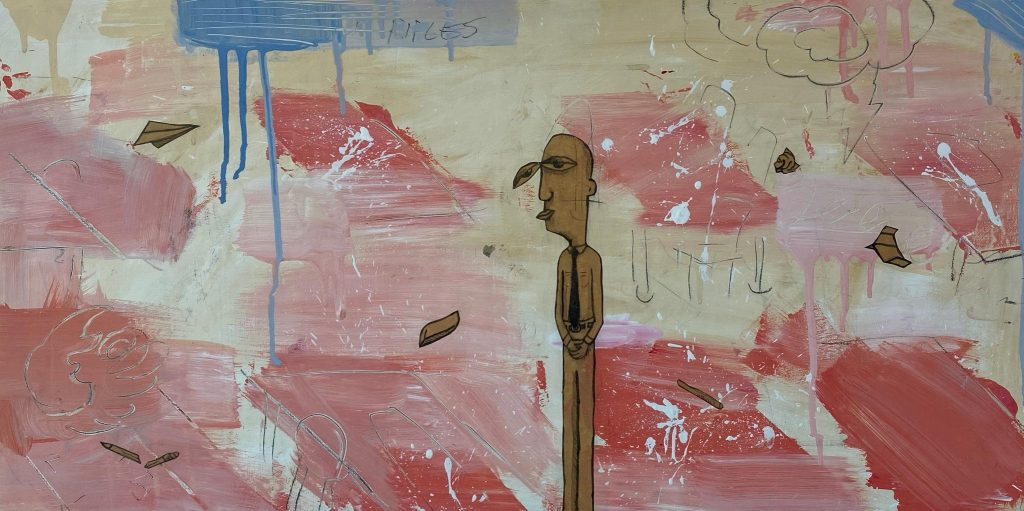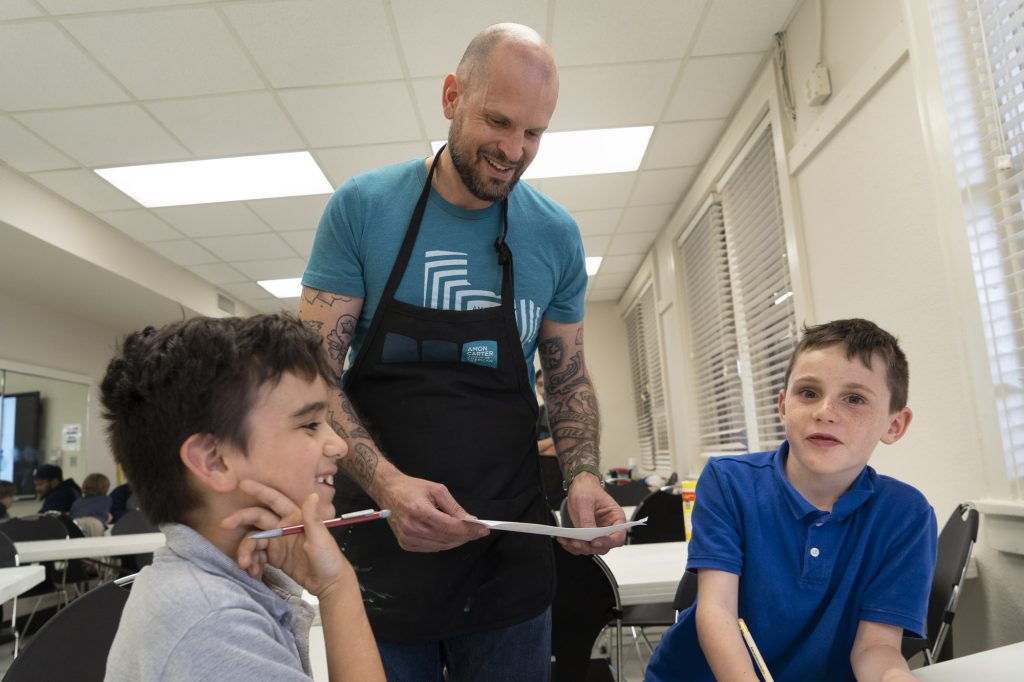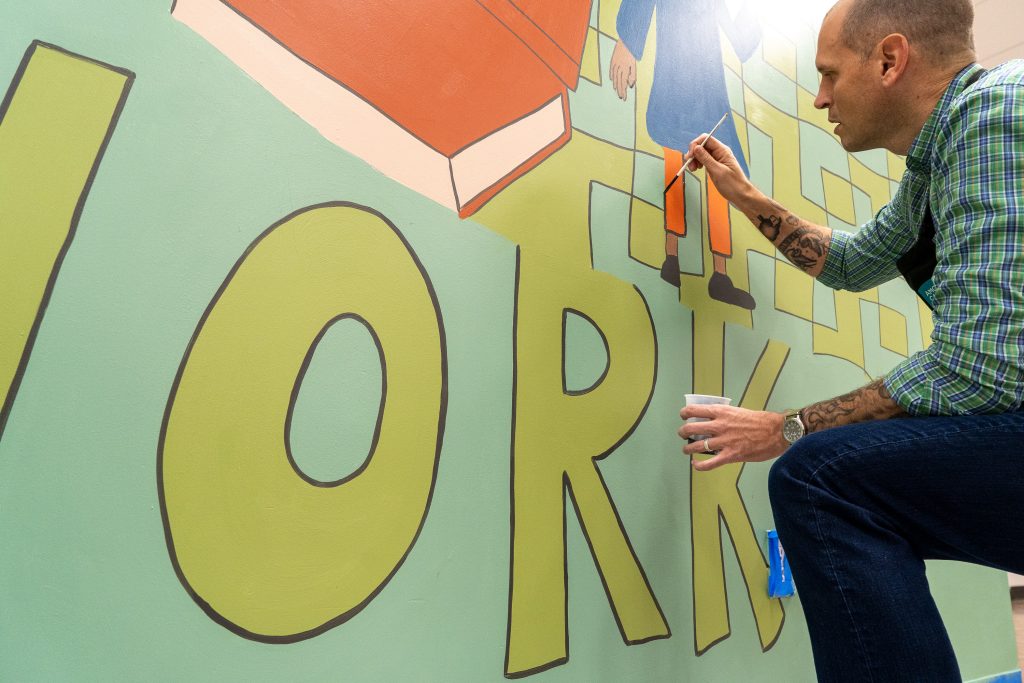From the Museum to the People
Like the careers of the artists whose works populate the Amon Carter Museum of American Art, Adam Werner’s path to artistic fruition was riddled with setbacks. Now the manager of the Amon Carter’s Community Teaching Program, Werner oversees a team of four teachers, two of whom are bilingual, and utilizes the vast resources of the Amon Carter to bring the museum’s mission of celebrating American creativity to young minds across Tarrant County.

“We work with a lot of younger students,” Werner said. “Because I had this roundabout path to my career, I try to show kids a little behind-the-scenes of what jobs are available in the artistic and museum worlds. If you don’t know what’s out there, how are you going to know [what career is right]?”
When the education director was a youth, he thought artists either taught art, made art, or worked in graphic design. The Tennessee native’s father was a pastor whose job kept the family moving to churches in Tennessee, Virginia, and East Texas.
“I grew up just being interested in art and doing a lot of drawing,” Werner recalled. “I was really into stuff that had a visual culture around it, like punk music and skateboarding. I was always keyed into the graphics on skateboards and record covers. I’d recreate those drawings and logos. For me, art, music, and skateboarding all went together.”
Marshall High School, near the Louisiana border, was typical of small-town Texas schools. Life centered around football and marching band. While maintaining a trio of skater friends, Adam met his current wife Robbie, although the two didn’t date until college. Looking back, he appreciates the mixed-socioeconomic student population which forced him to interact with folks from all walks of life.

photo credit: Brad Frace
“My art teachers were inventing new courses for two or three of us who were really serious about art,” he said. “That is when they were just starting to have digital art classes.”
Adam entered a portfolio competition offered by nearby Kilgore College and placed second. The accolade came with a steep cut in tuition, so he began college near his hometown before transferring to the University of North Texas (UNT) to study graphic design. Robbie was studying architecture at the nearby University of Texas, Arlington (UTA), when the two started dating. The couple’s circle of friends lived in the Mid-Cities, so Adam transferred again, this time to UTA.
If Adam’s career had a middle period, it focused on providing for his growing family. Before finishing his degree from UTA, Adam and Robbie married and moved to Tennessee for a few years. He was burned out on the idea of perching in front of a computer as a graphic designer and worked at a digital printing company and, later, at a health food store. With their first child, Amaris, on the way, Adam’s love of creating art would have to be put on hold.
Fond memories of visiting Fort Worth brought the family back to Cowtown in 2002, and Robbie found a job at the Kimbell Art Museum’s gift store.
“I realized I needed to go back and do what I loved doing, which was drawing and painting,” he said about his decision to finish his degree from UTA.
As Adam and Robbie juggled work and child-rearing, the couple placed spending time with their children over career-building. Adam worked nights at UPS, taking classes when Robbie wasn’t working at the Kimbell.
“[Amaris] would go to bed at 7,” Adam recalled. “That’s when I would go to bed before getting up for work at one or two in the morning.”
This life made college studies slow-going. With Paige, their second daughter, on the way, Adam finished his final courses on Robbie’s days off so their first daughter would be with at least one parent.
“I needed stability and health insurance,” Adam said of that time. “I opted to get a teaching certification. We chose to live frugally and struggle in a lot of ways but prioritized spending time with our kids.”
Adam’s time teaching elementary art in Castleberry ISD informs his current work at the Amon Carter, where he frequently coordinates with public school teachers and administrators. School hours and time at home planning for the next day took away from his artistic endeavors, but he still found periods of time to produce work.

Image courtesy of Adam Werner
“Teaching takes an incredible amount of time,” Adam said. “You are spending your evenings prepping for the next day,” Adam said. “Even if you had time available, you are mentally and physically taxed. When there were opportunities for a group show or exhibition, I made work in batches.”
When Adam could squirrel away time for personal projects, his day job was his muse. His drawings and paintings had common themes: paper airplanes, wads of paper, and school-related rituals like ironing on Sundays. The creative output, he said, was self-referential.
Artistic cohorts organized pop-up shows in Arlington and Fort Worth which gave Adam an outlet for his paper-strew visual artworks. In 2012, Robbie opened the uber-popular baked goods store, Stir Crazy. When she outgrew her original location, Robbie moved her business (which she recently sold to Leaves’ Tina Howard) to West Magnolia Avenue three years later.
After more than a decade teaching public school, Adam was ready for a break, so he worked with his wife for a year and a half.
“I was happy doing what I had been doing,” he said, “but I was doing the same thing for 11 years. I was ready for something different. It was nice on one level. We were paying both of our paychecks out of the business, though, and it wasn’t making financial sense.”
Adam considered teaching high school but had always been intrigued with the museum environment. When the Amon Carter posted a position for a community teaching lead, the former schoolteacher applied. The Amon Carter was expanding its outreach program, and the museum split its education program into two parts, with one organizing school tours to the Cultural District while another team brought the knowledge and resources of the museum to schools and community-based arts groups like Artes de la Rosa Cultural Center for the Arts on the North Side. Artist and writer Jessica Fuentes managed both programs which were overseen by Director of Education and Library Services Amanda Blake.
Under Fuentes’ leadership, the Amon Carter launched the Carter Community Artist Program which connects local artists with area youths. But early in the COVID-19 pandemic, Fuentes left the museum to focus on writing for Glasstire magazine and managing the gallery programs at Kinfolk House on the East Side.
After her departure, Adam envisioned splitting Fuentes’ role into two parts. The outreach program had grown significantly under her watch, and the work of the gallery and outreach teams was divergent enough to necessitate separate managers.
“Around that same time, the gallery teaching lead was leaving as well,” Adam recalled. “It didn’t make sense to me to have someone new come and take Jessica’s same role. I had started to take on more responsibilities and pitched the idea of managing the teams separately.”
Blake agreed. The gallery and community teaching teams would each have a manager. Now with a crew of four part-time staffers and interns, the outreach program provides arts-centered programs for K through 12 students through in-school programs and 14 community centers.

After-school program, Fire Station Community Center, March 5, 2020.
Photo courtesy of the Amon Carter Museum of American Art
“During the summer, we do camps at 10 community centers,” Adam said. “Those are hour-long on-site programs that present digital images from the collection. When we see those same kids come for a field trip, that is always exciting. We try to recreate the excitement of museum visits at the centers through art making where we discuss the Amon Carter’s artworks and have the students make something in response. That’s the basis of the afterschool and summer camps. Carter in the Classrooms is where we coordinate with teachers or administrators, so we connect with their curriculum. We have a huge archive and library and can pull from those resources. Our archivist can pull some amazing materials like photos, magazines, and books. We can use those to make connections to what they are talking about in the classroom.”
Fort Worth ISD partners with the Amon Carter to ensure that all fourth graders visit the museum at least once during the school year. While past generations of students enjoyed regular field trips to museums and cultural centers, today’s middle and high school teachers face stringent benchmark testing that make school outings less frequent, Adam said.
Over the past few years, Adam and his team have built close relationships with a handful of community partners which include Arts de la Rosa, LGBTQ Saves, Tarrant County Black Historical & Genealogical Society, and Cook Children’s Hospital.
Sharon Herrera remembers the chaos during 2020 that disrupted her nonprofit’s work with queer youths.
“We were panicking,” the LGBTQ Saves founder and director recalled. “The Amon Cater was one of the first groups to reach out to us to help. They provided virtual art meetings. We need more Adams in the world. He is a role model for kindness and inclusion.”
Using the social media app Discord, Adam and his team provided live programs that introduced Herrera’s youths to the museum’s collections as well as highlights of the work that goes on at the museum. One art-loving student didn’t realize that there were professional art guides known as docents.
Simply having programs specifically for LGBTQ children presented by a major cultural institution empowers the youths and teens, Herrera said.
“He is making sure that everyone is included,” Herrera added. “He knows our mission is to save lives, and he is showing young people that they can be authentic. The Amon Carter is an affirming space. Just to know that it is open for LGBTQ students is a blessing. The kids know it is a safe space.”
A recent survey by The Trevor Project, a nonprofit working to end suicide among queer youths, found 41% of lesbian, gay, bisexual, and transgender respondents have contemplated suicide. Every fourth Thursday of the month, Herrera’s kiddos spend the evening at the Amon Carter where meals, talks about art, and a loving environment are provided by museum staffers.
“The families are invited,” Herrera said. “It is a powerful relationship because of the way the world is. We rely on them heavily because we are volunteer based. The Amon Carter has been there consistently there for us for three years.”
Adam’s team recently began in-person visits in addition to providing virtual educational programs for patients at Cook Children’s. The Amon Carter, he said, is dedicated to always better serving its community partners.
“Over the years, one of the things that has been part of my role in growing this outreach program is deepening relationships and doing more frequent interactions.”

Photo courtesy of the Amon Carter Museum of American Art
It isn’t a top-down approach, he added. When presenting shows tied to the Hispanic community — such as the recent ¡Printing the Revolution! exhibit — Adam reached out to Artes de la Rosa directors for input.
“We aren’t always the experts,” he said. “We love to hear what the community has to say about what we are doing with certain shows. Those relationships are reciprocal.”
This year is the first that Adam and his team have been able to manage the public-school outreach program without COVID-related restrictions. Teachers can apply for a new partnership program with the Amon Carter that allows students to create large artworks like murals or installation pieces.
Fuentes said Adam’s past work as a public-school teacher and strong work ethic has allowed to grow the outreach program in a meaningful way.
“When I decided to leave the Carter in the middle of the pandemic, it was a tricky decision for a lot of reasons,” Fuentes said. “Still, it was made easier knowing that Adam would be there to carry on the work we had done together in the community. Besides being a talented artist and a thoughtful educator, Adam is a community-centered person. I have loved watching him and the new team of community teachers grow and evolve the community partnerships and programs offered by the museum.”
Fuentes recently attended an arts education conference in San Antonio and heard Adam speak during a conference session. “His passion, strong work ethic, and care came across as he recounted the work he and the team are doing,” Fuentes said.
Based on his years in public schools, Adam is confident that his team is well-versed in the needs of the community.
“We have a mix of people who have spent some time in the classroom,” he said. “Others are fresh out of school and gaining experience. I feel like that collective experience informs how we create the programs we do. We are trying to think about what the community needs while providing programs that are equitable and accessible.”
Adam’s circuitous path to being a museum director was beset with setbacks and pauses so he and his wife could prioritize parenting. It’s a backstory that enables Adam to connect with students who are unsure of what they want in life.
“I don’t necessarily recommend going the route I did,” he said with a laugh. “But there is value in each of the experiences I’ve had. They’ve all built and led to where I am today.”


 Sign in
Sign in

